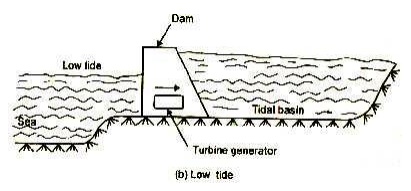Working principle of Tidal power plants
Tide or wave is periodic rise and fall of water level of the sea. Tides occur due to the attraction of sea water by the moon. Tides contain large amount of potential energy which is used for power generation. When the water is above the mean sea level, it is called flood tide. When the water level is below the mean level it is called ebb tide.
Working
The arrangement of this system is shown in figure. The ocean tides rise and fall and water can be stored during the rise period and it can be discharged during fall. A dam is constructed separating the tidal basin from the sea and a difference in water level is obtained between the basin and sea.

Figure: High tide
During high tide period, water flows from the sea into the tidal basin through the water turbine. The height of tide is above that of tidal basin. Hence the turbine unit operates and generates power, as it is directly coupled to a generator.
During low tide period, water flows from tidal basin to sea, as the water level in the basin is more than that of the tide in the sea. During this period also, the flowing water rotates the turbine and generator power.

Figure : Low tide
The generation of power stops only when the sea level and the tidal basin level are equal. For the generation of power economically using this source of energy requires some minimum tide height and suitable site. Kislaya power plant of 250 MW capacity in Russia and Rance power plant in France are the only examples of this type of power plant.
Advantages of tidal power plants.
1. It is free from pollution as it does not use any fuel.
2. It is superior to hydro-power plant as it is totally independent of rain.
3. It improves the possibility of fish farming in the tidal basins and it can provide recreation to visitors and holiday makers.
Disadvantages
1. Tidal power plants can be developed only if natural sites are available on the bay.
2. As the sites are available on the bays which are always far away from load centres, the power generated has to be transmitted to long distances. This increases the transmission cost and transmission losses.

